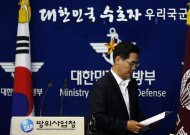By Joyce Lee and Ju-min Park
Lockheed Martin's (LMT) F-35A, previously considered too expensive, has shot to the front of the race for a multi-billion dollar deal after the Defence Ministry singled out a fifth-generation fighter as the preferred option.
Boeing's F-15 Silent Eagle, the only bid within budget, had been poised to win the 8.3 trillion won ($7.7 billion) tender. But former military top brass and ruling party legislators had criticized the aircraft for lacking stealth capabilities.
However, the air power of old rival North Korea was, by itself, not enough to warrant scrapping the tender in favor of stealth, experts said.
"It should not be hard to get air superiority against North Korea using conventional fighters because the air force is basically grounded, their pilots don't have any experience, and their air defence is from the 1950s," said Markus Schiller, senior analyst at Munich-based Schmucker Technologie.
"The capability that they get with the F-15 would be sufficient."
The North Korean air force operates a fleet of more than 1,300 aircraft, most of them Soviet-era models, the U.S. Department of Defense wrote in a report to Congress in 2012.
The North's most capable combat aircraft are its MiG-29s, one of which appeared as the backdrop in a photograph of North Korea's young leader, Kim Jong-un, posing with soldiers last year.
MiG-21 and MiG-23 jets make up most of the rest of North Korea's combat fleet of about 400 aircraft, according to intelligence estimates.
In contrast, South Korea had about 1,420 aircraft as of January 2012, with about 220 F-15Ks and F-16s as its main fighter jets.
But with North Korea's possible nuclear weapons a constant concern after three nuclear tests, the latest in February, supporters of the decision to re-issue the tender say the very presence of stealth jets can deter the North.
"Possession of stealth fighters can only apply pressure to North Korea," said Lee Han-ho, a former air force chief of staff between 2003 and 2005.
QUICK TURNAROUND NEEDED
Some defence experts also say that advanced fighters are needed not only to check North Korea. Japan is acquiring F-35s and China is developing J-20 stealth fighters.
Also, South Korea is due to take operational control of its forces from the United States in 2015, meaning it must consider ways to lessen its dependence on U.S. air power in the long term.
A main concern of the leadership of South Korea's air force has been delays that could cause a substantial gap in its air power before jets from the re-issued tender arrive.
South Korea's arms procurement agency, the Defense Acquisition Program Administration, had estimated that any delay in the tender process could leave the air force 100 fighters short of the 430 deemed necessary by 2019.
The Defence Ministry said on Tuesday it expected to complete the new purchase in about a year, keeping to the scrapped tender's timetable of a 2017 first delivery date.
But South Korea faces some hurdles before it can relaunch a tender and choose a winner within a year, including getting parliament's approval for next year's 732.8 billion won budget, which is earmarked for the program.
First delivery in 2017 could be a tall order if the budget is not secured and the winner is not chosen by next year.
Lockheed Martin, the current favorite, said the company can deliver a jet about two years after receiving an order, which would dispel most concerns about a shortage of jets.
But South Korean experience suggests it can take about three years for a winning bidder to build and deliver the first batch of "next-generation" fighter jets.
In its first high-class jet tender, which the Boeing F-15K won in 2002, it took three years for the first delivery, in 2005. The second such tender, awarded again to the Boeing F-15K in 2008, only took two years until delivery because the production lines already existed, experts say.
South Korea said on Tuesday it would consider all options, including buying a mix of different models when reframing the tender, in order to minimize the gap in combat capabilities.
U.S. and European industry executives took heart as a mixed fleet could afford Boeing or the Eurofighter consortium - the third bidder in the scrapped tender - a chance to sell a smaller number of jets to Seoul, in addition to likely F-35 sales.
"The fact is that the South Koreans are facing a defense gap unless they can replace their aging F-4s very soon," said one industry official. "Buying a mixed fleet would allow them to close that gap more quickly, and probably at a lower cost."
Such a move would also give Seoul some added resources if the F-35 program, which is running about three years behind schedule, hits further delays, the official said.
Separately, Yang Uk, a senior research fellow at the Korea Defence and Security Forum, said: "Going through the entire process in a year is not impossible, but the top brass will have to cut through a lot of red tape," said .
"There is a concern that legally needed steps might not get the full attention they deserve."
(Additional reporting by Jack Kim and James Pearson in SEOUL, Andrea Shalal-Esa in WASHINGTON; Editing by Robert Birsel and Kenneth Maxwell)


No comments:
Post a Comment